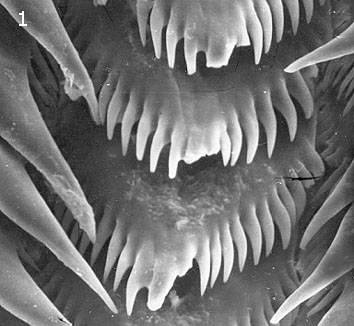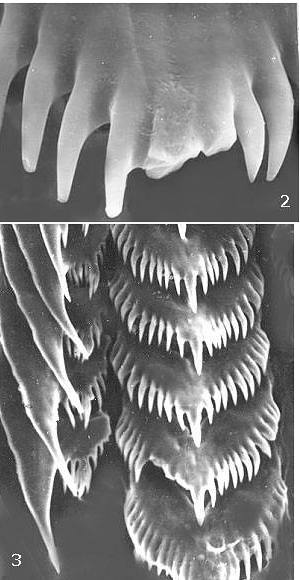'Coryphella' trophina and its feeding habits
April 18, 2003
From: Irina Roginskaya


The revision of literature data concerning four coryphellids from the North Pacific : Coryphella sp. Bergh,1879 (the single bulbus pharyngeus collected near Adakh Island, Aleutians), Coryphella trophina Bergh, 1894 (Port Althorp, Alaska), Coryphella fusca O'Donoghue,1921 (Vancouver Island region) and Aeolis camchatica Volodchenko,1941 (Avatcha Bay, East Kamchatka) led me to the conclusion on conspecifity of these species. Accordingly Coryphella sp., C. fusca and Aeolis camchatica are to be regarded as junior synonyms of Coryphella trophina [see Roginskaya, 1986, 1990]. I persist in considering Coryphella as a taxon distinct from Flabellina.
The results I got from the study of the samples from the Sea of Okhotsk and from the Bering Sea added new details to the feeding habits of this species. My material included six specimens of C. trophina: one - from the Bering Sea (59 57'2"N, 169 40'5"E, R/V "Vytiaz". Depth 115m. 24 June 1952) and five - from the Sea of Okhotsk, collected by N.A.Zarenkov in May-June 1958/: 1 ex. from 56 11'N,154 50'E.Depth 88m; 3 ex. from 56 00'N, 155 7'30"E.Depth 69m; 1 ex. from 57 29'3"N, 156 46'0" E. Depth 20m.
The radular teeth of all the specimens of C. trophina examined displayed the great degree of splitting and obliteration I described earlier (Roginskaya, 1969), unusual for hydroid feeders. And the study of stomach contents of two animals from the sea of Okhotsk discovered, side by side with fragments of hydroids, the rather unusual food objects for Coryphella - the pharyngeal bulbs of small sized nudibranchs Cuthona sp. and Coryphella verrucosa. In the stomach of one specimen [body length 25.5 mm] the pharyngeal bulbs of swallowed nudibranchs numbered as much as 10 ! The significant number of pharyngeal bulbs in the stomach indicates that the unusual destruction of the radular teeth may be caused by the contact of the teeth with rather hard prey -the jaws and radulae of swallowed nudibranchs. It also suggets that this predatory mode of feeding is apparently not accidental, but normal for the species. It is interesting to recall the observation of Bergh in connection with this species from Aleutian Islands [Bergh, 1879]. He found hanging out of a 5mm long buccal bulb of Coryphella sp. "a fine 6mm long Caprella". It seems also that Coryphella trophina - common along the Pacific Coast of North America as C. fusca - has a reputation for being voracious molluscs. It is no mere chance that in the "Suggested draft list" of Common Names List of North American Marine Gastropods, Part 3, pp.17-25 , appeared in Shells and Sea Life, 1985, vol.17, no.1, the common name of C. fusca is designated as "predaceous aeolid".
Thanks to Sandra Millen, who kindly sent me three specimens of C. fusca from the Vancouver Island region I could study by SEM the radular ribbons of Canadian representatives of the species. And again the radular teeth displayed the significant morphological variety as well as strong damage and splitting. From the photos of the radular teeth enclosed [Figs 1-3] it is seen that the central and lateral radular teeth are strongly armed with long denticles. It is obvious that the most loading during the feeding process falls on the central tooth of the radula [Figs.1,2]. And these cusps demonstrate the most drastic damage [Fig. 2]. The stomach contents of these Canadian animals contained bristles, setae and large fragments of polychaetes belonging to the family Chaetopteridae - most probably Spiochaetopterus. It seems doubtful that C. trophina would be content with just gathering dead nudibranchs and polychaetes, that is being a scavenger, relying on dead animals. But to be sure, it would be good if anyone could observe in nature how C. trophina attacks the mobile nudibranchs and polychaetes it apparently feeds on.
It seems to me that the seizure of the prey can take place by means of the original anterior three-cornered "cephalic shield", placed between the oral tentacles and bearing the deep groove. This organ is clearly demonstrated in the photos posted in the message from Jackie Hildering and Glen Miller. It looks like the upper lip of the slug is expanded out into a tube. Working with this tube over the bottom, C. trophina could capture the thin tubes of Spiochaetopterus, sending them to the mouth and extracting the worm from its tube by the action of strong mandibles and radula. So it is really possible, that the specimens from British Columbia could be preying on tube worms such as Diopatra ornata?
References:
• Bergh, L.S.R., 1879. On the nudibranchiate gastropod Mollusca of the North Pacific Ocean, with special results of those of Alaska. Sci.Results of the Exploration of Alaska. I, (5): 127-135.
• O'Donoghue, C., 1921. Nudibranchiate mollusca from the Vancouver Island Region. Transactions of the Royal Canadian Institute, Toronto, 13(1): 147-209.
3.Roginskaya, I.S. 1964. A large-sized nudibranch mollusk Coryphella fusca O'Donoghue - predator of small nudibranch mollusks Coryphella rufibranchialis Johnson and Cuthona sp. Zoologicheskii Zhurnal, 43(11): 1717-1719.
• Roginskaya, I. S. (1969) Taxonomy and ecology of the nudibranch mollusc Coryphella fusca. Zoologicheskii Zhurnal, 48: 1614-1617.
• Roginskaya I.S., 1986. Reader Forum (Coryphella trophina). Shells and Sea Life, 18(1): 17-18.
• Roginskaya, I. S. (1990) Data of feeding, distribution and synonymy of Coryphella trophina (Bergh, 1894) (Nudibranchia: Gastropoda), pp. 47-57, 151-152, 156. In: A. P. Kuznetsov, [Ed.], Feeding and bioenergetics of marine bottom invertebrates. Academy of Sciences of the U.S.S.R., P. P. Shirshov Institute of Oceanology, Moscow, 162 pp. [In Russian].
Irina Roginskaya
irina7@hotmail.com
Dear Irina,
Thanks for your interesting information. Firstly I agree it would be fascinating to get some first-hand accounts of how this animal feeds. On the question of its name. Considering the extremely large denticles on the radular teeth I fully agree with your suggestion that C. fusca and H. trophina are synonyms. However I am following standard practice, with which I agree, in considering Coryphella to be a synonym of Flabellina. There is a continuum of character variation within this group and I feel that if we agree to 2 genera we would soon need to increase that to satisfy the other slight differences to be found in the group. I guess we can only agree to differ. I have left Coryphella trophina in your message, but for consistency will use Flabellina trophina elsewhere in the Forum.
Thanks again for your interesting contribution,
Bill Rudman
Related messages
-
Re: Flabellina trophina feeding and laying eggs
From: Marli Wakeing, October 8, 2008 -
Re: Flabellina trophina feeding and laying eggs
From: Jeff Goddard, October 8, 2008 -
Re: Flabellina trophina feeding and laying eggs
From: Jackie Hildering, October 8, 2008 -
Flabellina trophina feeding and laying eggs
From: Marli Wakeling, October 3, 2008 -
Flabellina trophina or F. triophina ?
From: Daniel Hershman, September 25, 2007 -
Re: Flabellina trophina - egg laying
From: Jackie Hildering & Glen Miller, July 9, 2007 -
Flabellina trophina from British Columbia
From: Marli Wakeling, July 9, 2007 -
Re:Flabellina trophina ? from Japan
From: Yasuhiro Shamoto, July 24, 2006 -
Flabellina trophina ? from Japan
From: Yasuhiro Shamoto, July 19, 2006 -
Re: Flabellina trophina - feeding on worms
From: Ron Velarde, July 10, 2004 -
Flabellina trophina - feeding on worms [1]
From: J. Hildering and G. Miller, March 26, 2004 -
Flabellina trophina - feeding on worms [2]
From: J. Hildering and G. Miller, March 26, 2004 -
Flabellina trophina - egg laying
From: J. Hildering and G. Miller, March 26, 2004 -
Flabellina fusca - behaviour
From: Jackie Hildering & Glen Miller , April 2, 2003 -
Flabellina fusca from Alaska
From: Clinton Bauder, August 6, 2002 -
Flabellina fusca on egg mass from British Columbia
From: Marli Wakeling, November 9, 2001 -
Flabellina trophina or F. fusca?
From: Sandra Millen, October 17, 2001 -
Flabellina fusca or triopha?
From: Marli Wakeling, October 15, 2001 -
Flabellina fusca from British Columbia
From: Marli Wakeling, February 21, 2001 -
A colour variant of Flabellina fusca
From: Marli Wakeling, February 21, 2001
